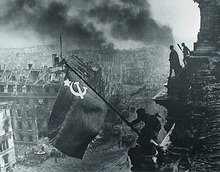|
|
Учебное пособие Кривцова, Кочетова. Учебное пособие для обучающихся по техническим и экономическим направлениям подготовки бакалавров
The Great Patriotic War 
The siege of Leningrad
The outbreak of the Second World War found the Soviet Union unprepared for the conflict ahead. Having signed a non-aggression pact with Germany in 1939, Hitler’s invasion of June 1941 caught the USSR by surprise. By the end of the year, the Germans had seized most of the Soviet Union’s western territory and surrounded Leningrad.
Leningrad’s horrific siege was one of the most lethal in world history. It lasted for 900 days, from September 1941 to January 1944. The city’s civilian population of almost three million refused to surrender, even though they were completely surrounded. By the first winter of the siege there was no heating, no water supply, almost no electricity and very little food. Somehow, the city survived, its heroic resistance summed up in the motto: “Troy fell, Rome fell, Leningrad did not fall”.
Defending the capital
Meanwhile the Germans advanced as far as Moscow, reaching the outskirts by early December 1941. Hundreds of young recruits were preparing to defend the capital. But none could imagine that before going to battle they would march on Red Square in front of Joseph Stalin and top Communist Party officials. Stalin held a military parade on Red Square on November 7 to mark the anniversary of the Bolshevik Revolution. The troops left Red Square to head straight to the frontline. The parade had a tremendous impact on morale in Moscow and throughout the Soviet Union. The capital never surrendered.
The siege of Stalingrad
Stalingrad (now Volgograd) was a major industrial centre on the Volga. Control over it opened the way to the vital Caucasus oil fields. The city’s very name drove Hitler’s obsession with it. Stalin’s order to the troops was: “Not One Step Back”. The horror of Stalingrad lasted for 199 days, costing an estimated 1.5 million lives from both sides. One building that the Germans failed to take was the so-called “Pavlov’s House”. In September 1942, a Soviet platoon led by Yakov Pavlov turned an apartment block in the city centre into an impenetrable fortress.
The cost of victory
… in May… 1945… Berlin finally fell.
The famous photo of two Soviet soldiers unfurling a red flag over the Reichstag became an iconic image of World War II. It was a symbol of the USSR’s triumph… the victory that came at a colossal cost.
The number of Soviet deaths was at first grossly distorted – the figure Stalin gave in 1946 was seven million. The USSR’s losses are now estimated at about 26.6 million. In the USSR the end of the war was considered to be May 9, 1945. The date has become a national holiday – Victory Day – and is commemorated in a grand military parade on Red Square.
Plural form of nouns
Существительные в английском языке, как и в русском, могут стоять в форме единственного или множественного числа.
Единственное число (singular) обозначает один предмет:
cup, gun, bubble
Множественное число (plural) обозначает два и более предмета:
three cups, two guns, thousands of bubbles
Английское существительное можно поставить во множественное число, прибавив к нему окончание -s. Оно читается как [ z ] после гласных и звонких согласных:
shoe – shoes
hen – hens
или как [ s ] после глухих согласных:
bat – bats
Если существительное оканчивается на свистящий или шипящий звук, то есть на буквы s, ss, x, sh, ch, то для него форма множественного числа образуется при помощи окончания -es [ iz ]:
bass – basses
match – matches
leash – leashes
box – boxes
Если существительное оканчивается на букву -y, перед которой стоит согласная, то во множественном числе -y меняется на i и к слову прибавляется окончание -es:
lobby – lobbies
sky – skies
Исключения: имена собственные (the two Germanys, the Gatsbys) и составные существительные (stand-bys).
Если перед буквой -y стоит гласная, то множественное число образуется по общему правилу при помощи окончания -s, а буква y остается без изменений:
bay – bays
day – days
way – ways
К существительным заканчивающимся на -o прибавляется окончание
-es:
potato – potatoes
tomato – tomatoes
hero – heroes
Исключения: bamboos, kangaroos, radios, studios, zoos, Eskimos, kilos, photos, pianos, concertos, solos, tangos, tobaccos.
Если же существительное оканчивается на буквы -f или -fe, то во множественном числе они меняются на -v- и прибавляется окончание -es:
thief –thieves
wolf – wolves
half – halves
wife – wives
Исключения: proofs, chiefs, safes, cliffs, gulfs, reefs
|
|
|
 Скачать 1.91 Mb.
Скачать 1.91 Mb.